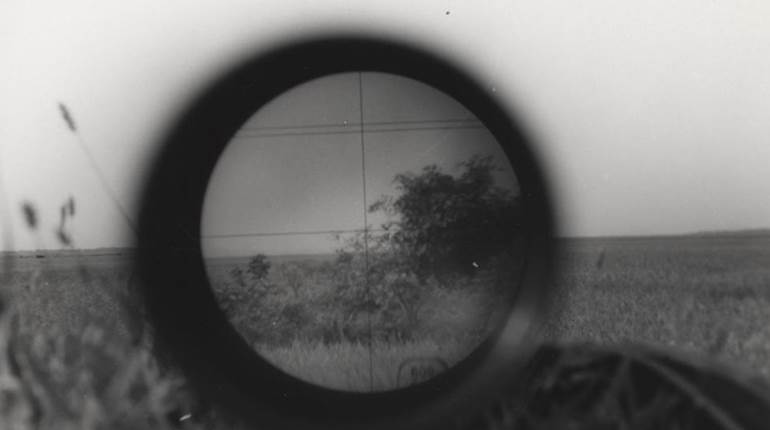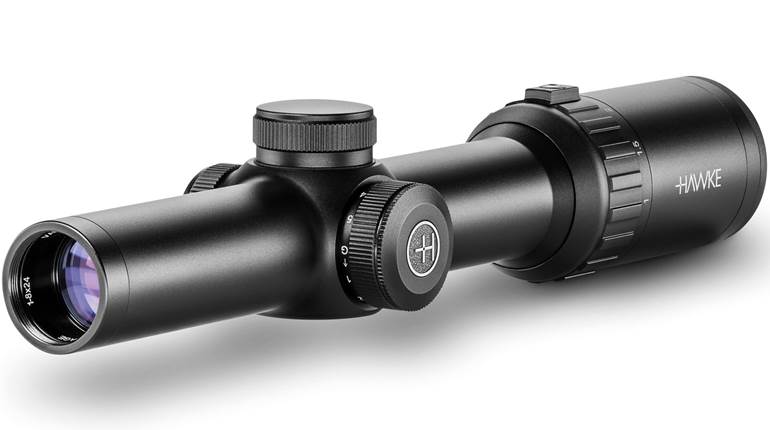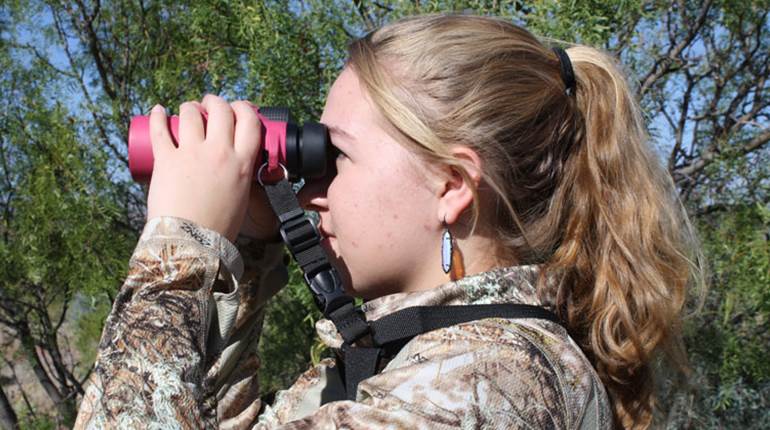
Bushnell, a company renowned for not only offering the latest technological advances in optics, but also for providing models for the cost-conscious outdoorsman, continues the trend with its Fusion 1600 ARC. Although rangefinding binoculars aren’t new, finding such technology along with truly beneficial “extras” in a platform affordable to the masses is, indeed, outside the norm.
Outwardly, the 31-ounces, 6¼ x 5½ x 2½-inch, 10X 42 mm Fusion 1600 ARC resembles the company’s many standard binoculars. In fact, the roof prism binocular, which has BaK-4 glass that is phase-corrected and has the company’s proprietary PC-3 phase coating, does share many commonalities, including: fully multi-coated optics; anti-reflective coatings; RainGuard HD hydrophobic lens coating; twist-up eye cups; rubber armor; and waterproof construction. What distinguishes it is found beneath the surface.
The aptly named Fusion 1600 ARC, which is powered by a CR123 3-volt battery (included), offers ranging accuracy to within plus or minus 1 yd./1 meter out to 1,600 yards/1,463 meters on highly reflective objects. Nonetheless, since target reflectivity, size, color and shape, as well as environmental conditions, influence true ranging effectiveness, real-world distances will be less—1,000 yards/914 meters for most objects.
The Fusion 1600 offers three “selective targeting modes.” For most ranging, the standard “Scan” mode is sufficient. When ranging game and small targets, or where the background targets have stronger signal strengths, “BullsEye” is the best option. In this mode, even when multiple objects are ranged the distance of the closer object will be displayed. “Brush” mode enables flora to be ignored so that only the distance of the desired target is determined. If multiple objects are acquired, the distance of the farthest object will be displayed.
Viewing and line-of-sight distance ranging are only two of the unit’s attributes: The Fusion 1600’s Angle Range Calculation (ARC) feature is its real advancement. The Fusion 1600 features “a built-in accelerometer-based inclinometer,” which, according to Bushnell, “provides elevation angle to allow for distance compensation when targeting objects that are either uphill or downhill. This data is then combined with internal algorithmic ballistic formulas.” Ultimately, degree of elevation, along with the line-of-sight distance, ballistic characteristics of the bullet/load and the sight-in distance, will determine the bullet drop/holdover (in rifle mode). The inclinometer is rated to be accurate within plus-or-minus 1 degree.
As the Fusion 1600 will serve both archery and rifle hunters, there are two correlating modes: bow and rifle. In the former, line-of-sight distance, degree of elevation and true horizontal distance out to 99 yards/meters are shown. Rifle mode, though, calculates and displays bullet drop in inches, minute of angle (m.o.a.) or centimeters—determined from line-of-sight distance, sight-in distance, degree of elevation and load/bullet characteristics. The latter is selected from a list of eight ballistic groups (A-H), as derived from Sierra Bullets’ ballistic programs. For muzzleloaders there are two (I and J) blackpowder-specific groups. When only line-of-sight distance is desired, there is the non-ARC Regular (rEG) mode.
Although the instruction manual lists only a few of the most popular factory loads, Bushnell’s website shows more than 2,000. Even if a specific load isn’t listed, one needs only to verify the bullet drop at 300 yards with a 100-yard zero and find the group that best correlates to it.
Setup of the Fusion is simple. Once powered (the reddish/orange button on unit’s right side), depressing the similarly colored mode button—on the top left side of the binocular—for three seconds puts the Fusion into “Setup,” and a subsequent push enables toggling between “Bow,” “Rifle,” or “rEG” modes. The power button then confirms the selection. Following this, the user chooses a unit of measure (yards or meters), Variable Sight-In (VSI) (100, 150, 200 or 300 yards/meters), measurement units of hold-over/bullet drop (inches or m.o.a. if yards is selected for unit of measure, or if meters was previously selected, then the default is centimeters), and the final option, display brightness. There are four intensity settings.
When using the ARC system in rifle mode, once the unit is powered, depressing the power button for approximately two seconds—while maintaining the aiming circle on-target—then letting off, the display will show the line-of-sight distance, and immediately right of it is the unit of measurement. Below those, the degree of angle will be shown for approximately one and a half seconds before the unit reveals the bullet drop/holdover—the most important number. The latter two measurements will toggle back and forth for five seconds before the unit shuts off.
In addition to traditional testing, which included water submersion for 15 minutes and freezing for one hour, followed by the unit returning to room temperature, both of which it passed without issue, the sample Fusion 1600 was taken to Africa by a Rifleman staff member. Although its ranging capability proved helpful throughout the safari, its true value came near the end of the hunt.
While hunting with Authentic African Adventures on Shelanti Game Ranch in the Limpopo province of South Africa, the hunter, professional hunter, tracker, guide and aide were glassing from a hilltop, when the PH spotted an old kudu bull below them. From their position the true distance was deceiving, but not to the Fusion, which showed a line-of-sight distance as 305 yards. Knowing the capability of the rifle accompanying him, a Nosler Model 48 Trophy Grade in .300 WSM, and being well-practiced, the shot was within reason; however, before he could ready the rifle the animal moved.
Finding the kudu again, the Fusion 1600 ARC revealed that it was now 265 yards away. With the exact bullet drop displayed, and also taking into account the speed and direction of the wind, as well as having a solid rest afforded by the Shooter’s Ridge bipod and the buttstock supported, the shot proved easy. The hunter delivered a 180-grain AccuBond through both shoulders and put the animal down within mere seconds.
With the Fusion 1600 ARC, Bushnell takes much of the guesswork out of shooting, particularly uphill and downhill, and it does so in a model that is affordable to all shooters. It could prove the difference in taking the trophy of a lifetime, or going home empty-handed.
Importer: Bushnell Outdoor Products; (800) 423-3537; www.bushnell.com
Model: Fusion 1600 ARC
Magnification and Objective: 10x42 mm
Finish: rubber
Field of View (Ft. @1,000 Yds.): 305
Exit Pupil: 4.2 mm
Length: 6¼"
Width: 5½"
Weight: 31 ozs.
Power Source: CR123 3-volt battery
Features: center focus; ARC
Accessories: lens covers; neck strap; battery; owner’s manual
Suggested Retail Price: $899






































